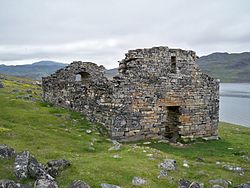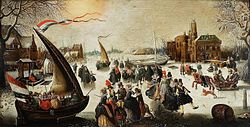Little Ice Age

The Little Ice Age (LIA) was a period of cooling after the so-called Medieval Warm Period.
Climatologists (people who study climate) and historians find it difficult to agree on either the start or end dates of this period. Some say the Little Ice Age started about the 16th century and continued to the mid 19th century. It is generally agreed that there were three minima, one beginning about 1650, one about 1770, the last one about 1850. Each time was separated by slight warming intervals.[1] At first, it was believed that the LIA was all over the world. Now it is not clear if this is true.
Solar activity
During the period 1645–1715, in the middle of the Little Ice Age, there was a period of low solar activity known as the Maunder Minimum. The physical link between low sunspot activity and cooling temperatures has not been established, but the coincidence of the Maunder Minimum with the deepest trough of the Little Ice Age is suggestive of such a connection.[2] The Spörer Minimum has also been identified with a significant cooling period near the beginning of the Little Ice Age. Other indicators of low solar activity during this period are levels of the isotopes carbon-14 and beryllium-10.[3]
Volcanic activity
Throughout the Little Ice Age, the world also experienced heightened volcanic activity.[4] When a volcano erupts, its ash reaches high into the atmosphere and can spread to cover the whole of Earth. This ash cloud blocks out some of the incoming solar radiation, leading to worldwide cooling that can last up to two years after an eruption.
Ocean conveyor shutdown
Another possibility is that there was a shutdown or slowing of Thermohaline circulation, also known as the "great ocean conveyor" or "meridional overturning circulation". The Gulf Stream could have been interrupted by the introduction of a large amount of fresh water to the North Atlantic, possibly caused by a period of warming before the little ice age. There is some concern that shutdown of thermohaline circulation could happen again as a result of global warming.[5]
End of Little Ice Age
Beginning around 1850, the climate began warming and the Little Ice Age ended. Some global warming critics believe that Earth's climate is still recovering from the Little Ice Age and that human activity is not the decisive factor in present temperature trends,[6][7] but this idea is not widely accepted.
Little Ice Age Media
The last written records of the Norse Greenlanders are from a 1408 marriage at Hvalsey Church, which is now the best-preserved Norse ruin.
River Thames frost fair, 1684
The Seine frozen, 3 January 1880. At the end of the 19th century, the climate was still colder than today.
Winter skating on the main canal of Pompenburg, Rotterdam in 1825, shortly before the minimum, by Bartholomeus Johannes van Hove
David Vinckboons, Winter Landscape with Skaters and Ice-Sailing (c. 1615)
The Reverend Robert Walker Skating on Duddingston Loch, attributed to Henry Raeburn, 1790s
References
- ↑ "Little Ice Age definition". Earth Observatory. Archived from the original on 2008-06-28. Retrieved 2007-08-02.
- ↑ "Changing Sun, Changing Climate". Archived from the original on 2006-06-17. Retrieved 2008-05-14.
- ↑ Crowley, Thomas J. (2000-07-14). "Causes of Climate Change Over the Past 1000 Years". Science. 289 (5477): 270–277. Bibcode:2000Sci...289..270C. doi:10.1126/science.289.5477.270. PMID 10894770.
- ↑ Robock, Alan (1979-12-21). "The "Little Ice Age": Northern Hemisphere Average Observations and Model Calculations". Science. 206 (4425): 1402–1404. Bibcode:1979Sci...206.1402R. doi:10.1126/science.206.4425.1402. PMID 17739301. S2CID 43754672.
- ↑ "A Chilling Possibility". Archived from the original on 2010-03-17. Retrieved 2008-05-14.
- ↑ Steigerwald, Bill (2007-02-10). The politics of global warming. Pittsburgh Tribune-Review. http://www.pittsburghlive.com/x/pittsburghtrib/news/mostread/s_492572.html. Retrieved 2008-05-14.
- ↑ Solomon, Lawrence (2007-03-30). Little Ice Age is still with us. National Post. http://www.canada.com/nationalpost/news/story.html?id=94b7d021-c5da-4e82-b37f-53d338709fb1.
Other websites
| Wikimedia Commons has media related to Lua error in Module:Commons_link at line 62: attempt to index field 'wikibase' (a nil value).. |
- Abrupt Climate Change Information from the Ocean & Climate Change Institute Archived 2009-04-11 at the Wayback Machine, Woods Hole Oceanographic Institution
- The Next Ice Age Archived 2007-01-29 at the Wayback Machine (discussion of Woods Hole research)
- IPCC on Was there a Little Ice Age and a Medieval Warm Period? Archived 2006-05-29 at the Wayback Machine
- Huascaran (Peru) Ice Core Data from the NOAA/NGDC Paleoclimatology Program
- Abrupt Decrease in Tropical Pacific Sea Surface Salinity at End of Little Ice Age ("indicates that sea surface temperature and salinity were higher in the 18th century than in the 20th century")
- Dansgaard cycles and the Little Ice Age (LIA) [dead link] (it is not easy to see a LIA in the graphs)
- The Little Ice Age and Medieval Warming in South Africa Archived 2007-10-26 at the Wayback Machine
- Was El Niño unaffected by the Little Ice Age? Archived 2008-01-30 at the Wayback Machine
- Evidence for the Little Ice Age in Spain
- On LIA Archived 2008-08-22 at the Wayback Machine
- Dutch Cloud an Landscape Painting in the LIA Archived 2007-03-13 at the Wayback Machine









